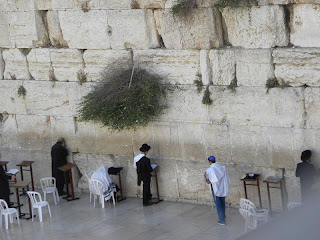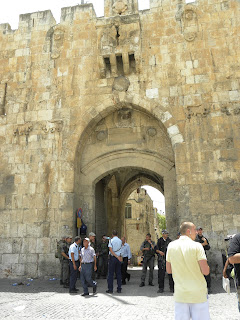










Wednesday 6-16 Temple Mount and Garden of Gethsemane
My last trip into the Old city...we go through the Dung Gate (East side of the Old city) to enter the Temple Mount (Mount Moriah), one of the most holy places of Islam and Judaism. To the Jews, this is the location of Solomon's temple (and, they hope, the new temple); to the Muslims, this is the location of Muhammad's ascent into heaven. As we walk the ramp towards the entrance we pass over the Wailing Wall which is the only major portion of the original Jewish Temple. Daily the jews will come here to pray, often stuffing paper with petitions written upon them into the cracks of the stone wall.
When we first enter the Temple Mount we see an old building that was a Christian Church, then Mosque, then Christian and now it again belongs to Islam. To our left we can see the Dome of the rock, a 8-sided (I think) structure topped with a dome of golden tiles. (Kinda like my geodesic dome home--ha!) According to Aaron, the writing along the top of the Dome state over and over again in Arabic "God has no Son".
To the right of the Dome is another, smaller dome structure that marks the center of the world, which I assume is based on the imaginary longitude and latitude lines of the earth. You will see a picture of this structure and then a photo of me standing in its center. Around the back of the Dome is another small structure which is supposed to be the actual location of the almost-offering of Issac which marks where the new Temple of the Jews is supposed to be located. Tradition states that the Muslims will not enter into this open structure for fear of death--the 2 Muslims that did evidently died. We entered and were just fine! I took a picture of the bared rock floor...original rock of Mt. Moriah.
The entire HUGE area is enclosed in walls and each main entrance to the Dome area is decorated with pillared gateways. Opposite the entrance we took is "the Golden Gate" or Mery Gate (I think) which is where the Messiah is to return. Across the street from this gate is the garden of Gethsemane and the Mount of Olives.
The Garden was nice. There is a church there (of course!) with arched ceilings. The exterior corners are decorated with Lion heads--quite nice. the garden has many OLD olive trees and various other plants. While we were inside a group was taking communion. the priest presiding over communion lead the people in the Eucharist song which echoed through the old church. It was quite awesome to hear!
After the church we went into the Jewish quarter of the Old City and visited the shop of an elderly Jewish artist who Aaron knew. I decided to get a portrait done. It was very interesting speaking with this kind man and having him draw a portrait of me. After that it was time to eat (bagel, cream cheese, veges and lox-yum!!) then off to Bethlehem. It was a short day (left Bethlehem at 7am returned at 1pm) but a full day.
Tomorrow evening I go to the airport and take the flight to Philadelphia. Then I need to catch the connecting flight to SFO--after going through customs, getting baggage and checking in prior to the departure scheduled for 2 hrs after I arrive. Do pray that I get the flight!!!
Blessings to all!
Deborah


































